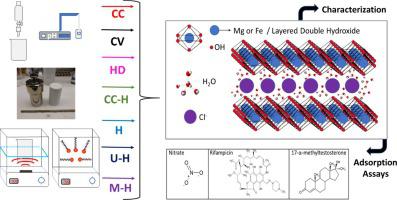Separation and Purification Technology ( IF 8.1 ) Pub Date : 2021-01-18 , DOI: 10.1016/j.seppur.2021.118353 Anamália Ferreira da Silva , José Leandro da Silva Duarte , Lucas Meili

|
Seven different routes to produce MgFe Layer Double Hydroxides (LDH) were tested. This study aims to explore different methods of MgFe-LDH synthesis and to analyze the physicochemical properties of the obtained materials (phase purity, crystallinity, and textural features). For this, synthesized materials via co-precipitation, hydrothermal, ultrasound irradiation and microwave were characterized by XRD, FT-IR, SEM, EDX, zeta potential and N2 adsorption/desorption. The characterization study allowed to classify, in terms of adsorption applications, as the best material formed, that obtained by synthesis with ultrasound irradiation followed by hydrothermal treatment. Then, the efficiency for the applicability of the materials was tested by removing pollutants of emerging concern (nitrate, antibiotic rifampicin, and hormone 17-α-methyltestosterone from water). For the hormone, removal was not satisfactory, achieving only 9.4% for microwave synthesis followed by hydrothermal treatment. On the other hand, ultrasound synthesis followed by hydrothermal, was able to remove 76.6% of Nitrate and 82.5% of rifampicin. Such findings corroborate the physical–chemical properties presented by the materials characterizations. As well as they suggest a synthesis route for an adsorbent capable of removing both inorganic and organic pollutants that has raised great concerns about the presence and bioaccumulation in aquatic environments.
中文翻译:

MgFe / LDH合成和应用的不同途径,以消除新出现的污染物
测试了生产MgFe层双氢氧化物(LDH)的七种不同途径。这项研究旨在探索MgFe-LDH合成的不同方法,并分析所得材料的物理化学性质(相纯度,结晶度和组织特征)。为此,通过XRD,FT-IR,SEM,EDX,ζ电势和N 2对通过共沉淀,水热,超声辐射和微波合成的材料进行了表征。吸附/解吸。根据吸附应用,表征研究可以将形成的最佳材料分类为通过超声辐射合成然后进行水热处理获得的最佳材料。然后,通过从水中去除新出现的污染物(硝酸盐,抗生素利福平和激素17-α-甲基睾丸激素)来测试材料的适用性。对于激素,去除效果不令人满意,微波合成然后进行水热处理仅达到9.4%。另一方面,超声合成然后水热能够去除76.6%的硝酸盐和82.5%的利福平。这些发现证实了材料表征所呈现的物理化学特性。









































 京公网安备 11010802027423号
京公网安备 11010802027423号